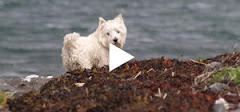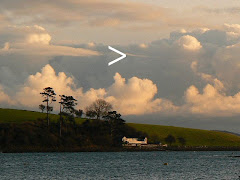Cetorhinus maximus: Basking Shark
(or Bone Shark, Elephant Shark, Hoe-mother or Sun-fish)
The following is from http://www.new-brunswick.net/:
"The basking shark is the second largest fish in the world, second only to another filter feeder, the whale shark. This animal can attain lengths of at least 10 meters (33 feet), but the average size is 7-9 meters. They can weigh up to 4 tons. The shape of its snout is conical and the gill slits extend around the top and bottom of its head. Associated with the gills are structures called gill rakers. These gill rakers are dark and bristle like and are used to catch plankton as water filters through the mouth and over the gills. The basking shark is usually grayish-brown in colour and often seems to have a mottled appearance. The caudal (tail) fin has a strong lateral keel and a crescent shape. The teeth in the basking shark are very small and numerous and often number one hundred per row. The teeth themselves have a single conical cusp, are curved backwards and are the same on both the upper and lower jaws.
Basking sharks are a migrating species and are believed to overwinter in deep waters. They may occur in either small schools or alone. Small schools in the Bay of Fundy have been seen swimming nose to tail in circles in what may be a form of mating behavior. Basking sharks are not aggressive and generally harmless to people. The number of basking sharks is unknown, but may be decreasing since the basking shark is hunted for its meat, fins and oil."















